9 Types of Water Pumps & Their Uses
Water pumps are used in various settings, ranging from construction, agricultural, industrial and even residential.
Where there’s excess water that needs removal, a water pump is used to carry out the draining process as quickly as possible.
There’s a variety of different types of water pump however.
In the chapters below, we delve deeper into each one, including their respective features in more detail.
Article Chapters
What is a Water Pump?
A water pump is a device whose main job is to increase water pressure in order to transfer the water, or liquid, from one place to another.
Water pumps can be powered by electricity, gas, diesel, and in remote places, even by means of solar energy.
There are different types of water pumps, but the main principle remains the same.
The motor converts the energy (kinetic or rotational) into hydrodynamic energy for the fluid flow.
What Does a Water Pump Do?
Firstly, it’s important to point out that there’s two main categories of water pumps, namely:
- centrifugal pumps, and
- positive displacement pumps
While both of these types of pumps are designed to continuously move water from one point to another, the way they do so differs as we explore in further detail below.
The main purpose of any water pump is to move water or a particular liquid from one point to another.
This includes water extraction such as during excavations, after severe flooding, at sewage plants or from wells.
1. Positive Displacement Pumps
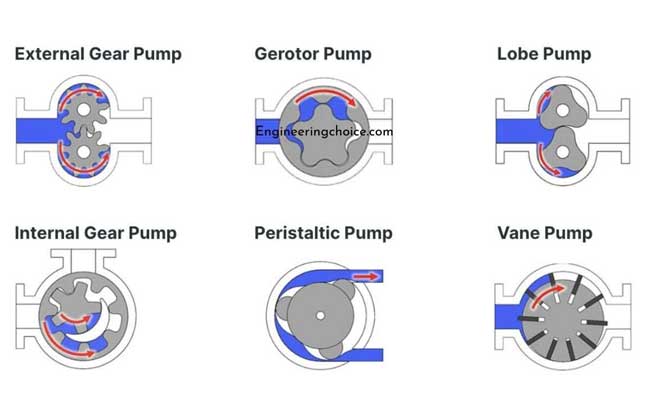
Image credit: Engineering Choice
Positive displacement pumps work by delivering a fixed amount of water through mechanical contraction and expansion of a flexible diaphragm.
While such pumps are relatively efficient, there is the drawback that they need a very small clearance between the rotating pump and the unit’s outer edge.
Hence, rotation might be carried out at a slow speed.
In cases when higher speeds are necessary, the liquids might erode and consequently reduce the pump’s overall efficiency.
Typical Uses
Positive displacement water pumps are commonly used as they are very efficient.
This is mainly because they remove air from the lines and consequently, eliminate the need for bleeding.
These pumps are ideal for liquids that have a high viscosity and where sensitive solids might be present.
2. Rotary Displacement Pumps
Rotary displacement pumps include gear pumps, screw pumps, hollow disk pumps, rotary vane pumps and vibratory pumps.
All of these are considerably efficient as they are able to manipulate highly viscous fluids which typically have higher flow rates.
Typical Uses
Such pumps are most commonly used to circulate lubricating oil in mechanical equipment.
They are also used to provide pressure for hydraulic operating systems.
3. Dynamic Pumps
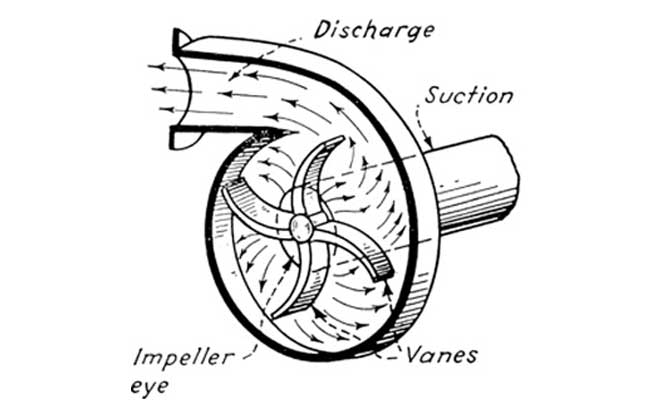
Image credit: Science Direct
Dynamic, or rotodynamic pumps, are velocity pumps which add kinetic energy to the fluid to raise its flow velocity.
As a result, the higher energy is transformed into pressure, until the velocity decreases as it nears the discharge line.
Typical Uses
Dynamic pumps are used for water supply, to pump crude oil as well as in the food industry.
They are also commonly used in the chemical industry, and various commercial applications.
4. Centrifugal Pumps
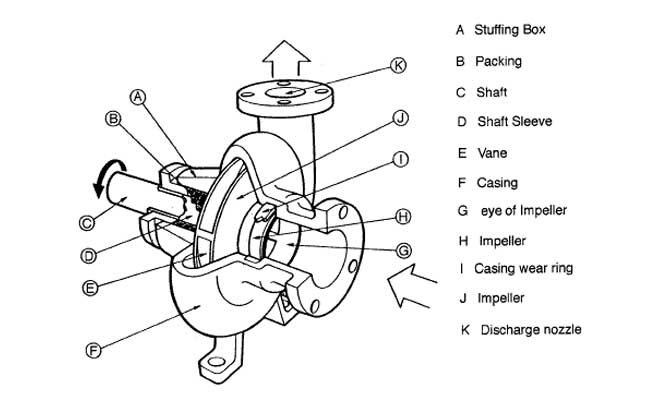
Image credit: Nuclear Power
A centrifugal water pump makes use of a rotating impeller in order to move the water within.
Then it pressurises the discharge flow.
There are different types of centrifugal water pumps, including standard models and submersible models.
At times these kinds of pumps need recirculating liquid in order to prevent overheating problems which can be caused by low flows.
It is also important to prime or fill the pump with the pumped fluid in order to help it work properly.
Typical Uses
These pumps work well when thin liquids need to be handled.
As a result, practically all kinds of liquids, even those with low viscosity can be pumped with centrifugal pumps.
They offer very high flow rates too.
Centrifugal pumps are used in various kinds of water system applications, especially for agricultural purposes.
Such pumps will typically move water from a dam or bore, direct it to the pipes for storage or to use it for irrigation.
These pumps are also used for dewatering and in pumping sewage and construction-related applications.
They are commonly used to pump water supplies in buildings, and to pump water from domestic wells.
Such pumps are also used to boost the pressure in the water intake lines.
Most centrifugal pumps are compatible with pneumatic systems too.
5. Axial & Radial Centrifugal Pumps
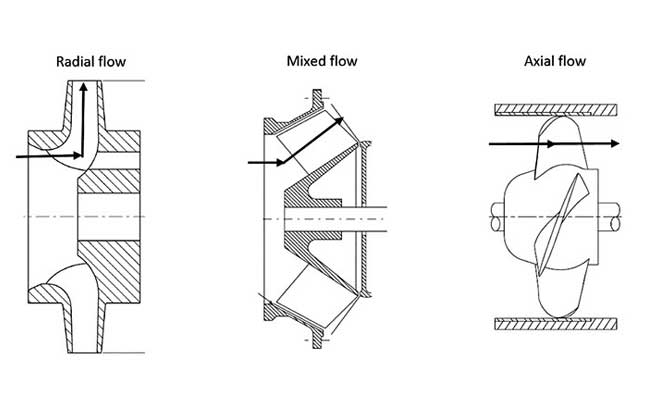
Image credit: Pumps & Systems
Radial centrifugal pumps pressurise the pumped flow and move it outwards through downstream piping.
Axial pumps provide fluid motion by means of a lifting force caused by the impeller vanes.
Typical Uses
Such pumps are typically used in diverse commercial, industrial and domestic settings.
These include the provision of water supply in residential areas, sewage disposal, in chemical, food and beverage manufacturing, as well as in oil and gas industrial operations.
6. Reciprocating Pumps
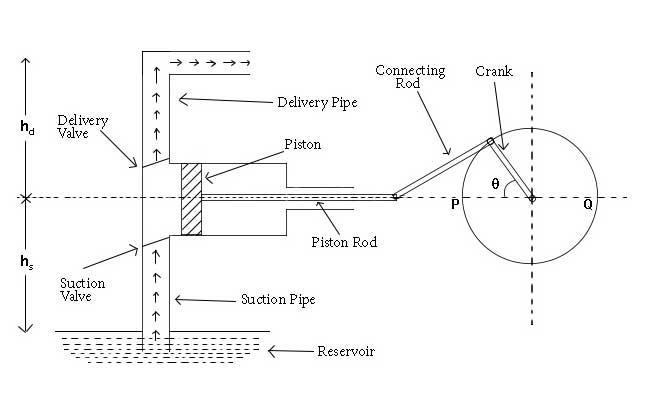
Image credit: Quora
Reciprocating pumps fall under the positive displacement pumps category.
They have an expanding cavity on the suction side, and a decreasing cavity on the discharge side.
The water pump will work by filling the cavity and displacing the fluid.
This is done alternately and with each cycle a constant volume is carried out.
Typical Uses
Reciprocating pumps are commonly used to pump high viscosity fluids, such as oils, resins and paints.
They are ideal in applications where high pressure output is required.
Such pumps are generally self-priming and since they have the advantage of not being affected by pressure levels, they are ideal in applications where the supply is irregular.
7. Submersible Pumps
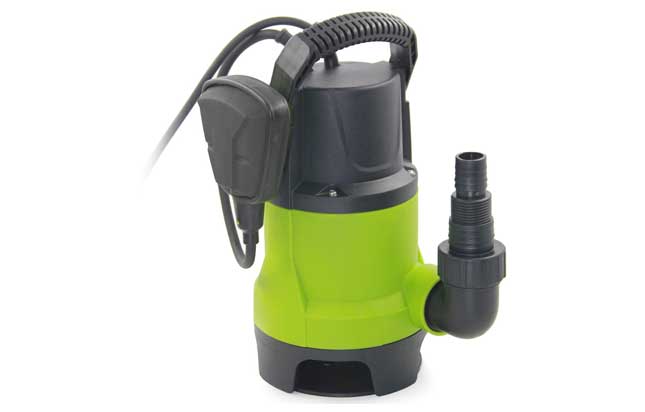
Image credit: Amazon
Submersible pumps, as the name itself implies, will be submerged in the fluid.
They operate by using the principle of electric submersible pumping.
By lowering the flow pressure, the pressure at the bottom is also decreased.
Typical Uses
Such pumps can be quite expensive since they might require the use of special electricity cables, and the electric usage is generally considerably higher.
They are used in deep wells such as oil wells, and in applications where the motor is able to operate under high pressures and temperatures.
They are also suited to dealing with groundwater flooding in basements to keep properties dry, using sump pumps that sit inside a pit.
8. Peristaltic Pumps
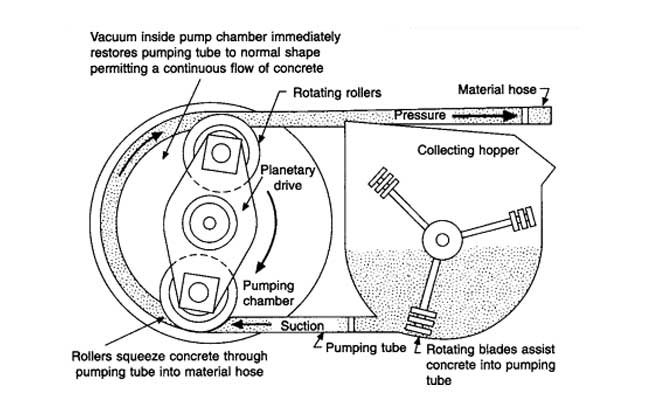
Image credit: Science Direct
A peristaltic pump is sometimes also referred to as a hose pump or a tube pump.
This type of pump works by applying positive displacement principles, whereby the fluid is supplied in the tubing by rotating rollers.
Then it is squeezed in a soft tube, and as the roller passes through it, it expands and forms a vacuum.
This enables the fluid to enter.
These rollers rotate either directly or by a motor, and there is no need for valves in such pumps.
Such pumps have the advantages of being self-priming and ideal for flow regulation.
They are tolerant to contamination with particles.
Typical Uses
These kinds of pumps are ideal in cases where viscous and corrosive fluids are being handled.
This is because the only piece of the pump which comes into contact with the liquid is the tubing.
These pumps are relatively maintenance free.
9. Diaphragm Pumps
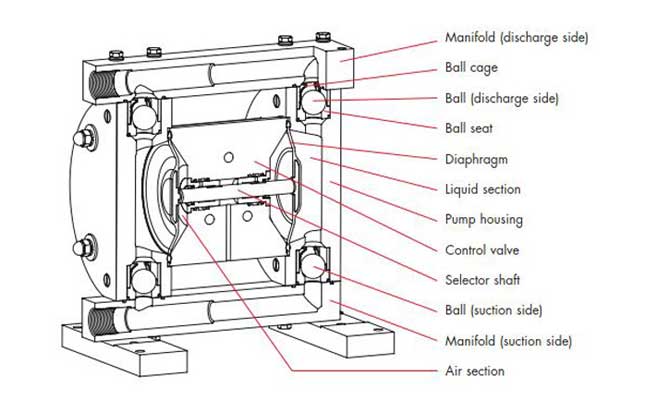
Image credit: Flux Pumps
A diaphragm pump, or membrane pump is another type of positive displacement pump.
The diaphragm is either made from rubber, thermoplastic or Teflon.
Its reciprocating action combined with the proper valves on the sides will pump the liquid.
There are three main types whereby:
The diaphragm is sealed with one front in the liquid being pumped, and the other in air, or in hydraulic liquid.
This diaphragm is flexible, so the volume of the pump chamber can increase or decrease as required. There is a set of non-return valves which block the reverse flow.
Electro-mechanical movement is carried out, and the system flexes the diaphragm, which has one head open for air.
One or more unsealed diaphragms are employed to pump on both heads.
When the volume of a chamber is increased, the pressure will diminish and as a result the fluid will make its way in the chamber.
This will later rise so that the fluid is driven out.
The cycle ends when the diaphragm moves up.
Typical Uses
Such pumps are generally used when chemicals such as acids, bleach and caustics are involved.
They are also used to move abrasive fluids such as concrete.
These pumps are also commonly found in the aircraft and automobile industries.
What Type of Water Pump Do I Need?
Since there are several different types of pumps, you may feel a bit overwhelmed as to which one you should choose.
There are a number of factors that you will need to take into consideration before choosing, including:
- The flow rate
- The horsepower
- The motor type
- The fuel needed, e.g. electricity, diesel, gas, hydraulic
- The material it’s made from as in case of exposed applications it is important to opt for a pump made from weather-resistant materials.
- Total head discharge or maximum pump power to make sure that it is sufficient for the particular application.
- The operation’s site and size, as well as the distance involved.
Conclusion
Being aware of the various types of water pumps will allow you to choose the most suitable one for your needs.
Each of the water pumps has its respective pros and cons, and a number of considerations need to be taken into account prior to choosing.
It is recommended that you consult a professional pump expert so that you can be guided accordingly.


Comments are closed.